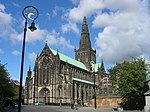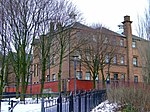Bishop's Castle, Glasgow
Buildings and structures demolished in 1789Castles in GlasgowDemolished buildings and structures in ScotlandEpiscopal palaces in ScotlandFormer castles in Scotland ... and 1 more
Use British English from December 2016

The Bishop's Castle (also known as Glasgow Castle, the Bishop's Palace, and the Archbishop's Palace) was a medieval castle in Glasgow, Scotland. It stood to the west of Glasgow Cathedral, covering much of the present day Cathedral Square. The castle served as the residence of the Archbishops of Glasgow until 1689. Following the Glorious Revolution, the castle became the property of the Crown. It fell into disrepair during the 18th century, having been used as a quarry from 1755, and the site was cleared in 1789 to make way for the Glasgow Royal Infirmary.
Excerpt from the Wikipedia article Bishop's Castle, Glasgow (License: CC BY-SA 3.0, Authors, Images).Bishop's Castle, Glasgow
Cathedral Precinct, Glasgow Townhead
Geographical coordinates (GPS) Address Nearby Places Show on map
Geographical coordinates (GPS)
| Latitude | Longitude |
|---|---|
| N 55.862777777778 ° | E -4.2363888888889 ° |
Address
Cathedral Precinct
Cathedral Precinct
G4 0QZ Glasgow, Townhead
Scotland, United Kingdom
Open on Google Maps










